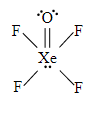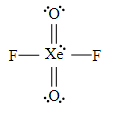
Concept explainers
Interpretation: The Lewis structures of the molecules and ions are to be represented.
Concept introduction:
The Lewis structure is a representation of bonding and nonbonding electron pairs present in the outermost shells of the atoms present in a molecule.
The number of bonds formed by an atom in the molecule is determined by the valence electrons pairs.
Dots are placed above and below as well as to the left and right of symbol.
Number of dots is important in Lewis dot symbol but not the order in which the dots are placed around the symbol.
In writing symbol pairing is not done until absolutely necessary.
For metals, the number of dots represents the number of electrons that are lost when the atom forms a cation.
For second period non-metals, the number of unpaired dots is the number of bonds the atom can form.
Atomic ions can also be represented by dot symbols, by simply adding (for anions) and subtracting (for cations) the appropriate number of dots from Lewis dot symbol.
The octet rule states that every atom reacts to form bonds till its octet of electrons gets completely filled.
Answer to Problem 72QP
Solution:
a)

b)

c)

d)

e)

Explanation of Solution
a)
The electronic configurations of xenon and fluorine in
A fluorine atom contains five valence electrons in its
The Lewis structure of

b)
The electronic configurations of xenon and fluorine in
A fluorine atom contains five valence electrons in its
Hence, the Lewis structure of
The Lewis structure of

c)
The electronic configurations of xenon and fluorine in
A fluorine atom contains five valence electrons in its
Hence, the Lewis structure of
The Lewis structure of

d)
The electronic configurations of xenon, oxygen, and fluorine in
A fluorine atom contains five valence electrons and oxygen contains four electrons in its
The Lewis structure of

e)
The electronic configurations of xenon, oxygen, and fluorine in
A fluorine atom contains five valence electrons and oxygen contains four electrons in its
The Lewis structure of

Want to see more full solutions like this?
Chapter 8 Solutions
Looseleaf Study Guide For Chemistry
- Nitrosyl azide, N4O, is a pale yellow solid first synthesized in 1993. Write the Lewis structure for nitrosyl azide.arrow_forwardChloral, Cl3C—CH=O, reacts with water to form the sedative and hypnotic agent chloral hydrate, Cl3C—CH(OH)2. Draw Lewis structures for these substances, and describe the change in molecular shape, if any, that occurs around each of the carbon atoms during the reaction.arrow_forwardAluminum oxide (Al₂ O₃) is a widely used industrial abrasive(emery, corundum), for which the specific application depends onthe hardness of the crystal. What does this hardness imply about the magnitude of the lattice energy? Would you have predictedfrom the chemical formula that Al₂ O₃ is hard? Explain.arrow_forward
- Methanol, CH3OH, may be an excellent alternative fuel. The high-temperature reaction of steam and carbon produces a mixture of the gases carbon monoxide, CO, and hydrogen, H2, from which methanol can be produced. Using the bond energies as shown, calculate the approximate enthalpy change, ΔH, for the reaction here: CO(g) + 2H2(g) ⟶ CH3 OH(g)arrow_forwardDraw a Lewis structure for carbonate ion, CO32-. Based on this Lewis structure, the calculated value for the formal charge on the carbon atom isarrow_forwardThe magnitude of the lattice energy (energy required to separate the ions) for the compounds K2O and CaO are shown below with respect to Coulombic attraction, which is the best explanation for the difference in lattice energy?arrow_forward
- Write all resonance structures of chlorobenzene, C6H5Cl, a molecule with the same cyclic structure as benzene. In all structures, keep the CCl bond as a single bond. Which resonance structures are the most important?arrow_forwardDraw a Lewis structure for each of the following molecules or ions. (a) CS2 (b) BF4 (c) HNO2 (where the bonding is in the order HONO) (d) OSCl2 (where S is the central atom)arrow_forwardIn which of the following molecules does the sulfur have an expanded octet? For those that do, write the Lewis structure. (a) SO2 (b) SF4 (c) SO2Cl2 (d) SF6arrow_forward
- Write reasonable Lewis structures for the following species, none of which follow the octet rule. (a) BF3 (b) NO (c) CO+ (d) ClO3arrow_forwardDefine the term lattice energy. Why, energetically, do ionic compounds form? Fig. 3-8 illustrates the energy changes involved in the formation of MgO(s) and NaF(s). Why is the lattice energy of MgO(s) so different from that of NaF(s)? The magnesium oxide is composed of Mg2+ and O2 ions. Energetically, why does Mg2+O2 form and not Mg+O? Why doesnt Mg3+O3 form?arrow_forward
 Chemistry: Principles and PracticeChemistryISBN:9780534420123Author:Daniel L. Reger, Scott R. Goode, David W. Ball, Edward MercerPublisher:Cengage Learning
Chemistry: Principles and PracticeChemistryISBN:9780534420123Author:Daniel L. Reger, Scott R. Goode, David W. Ball, Edward MercerPublisher:Cengage Learning Chemistry: Principles and ReactionsChemistryISBN:9781305079373Author:William L. Masterton, Cecile N. HurleyPublisher:Cengage Learning
Chemistry: Principles and ReactionsChemistryISBN:9781305079373Author:William L. Masterton, Cecile N. HurleyPublisher:Cengage Learning Chemistry: The Molecular ScienceChemistryISBN:9781285199047Author:John W. Moore, Conrad L. StanitskiPublisher:Cengage Learning
Chemistry: The Molecular ScienceChemistryISBN:9781285199047Author:John W. Moore, Conrad L. StanitskiPublisher:Cengage Learning General Chemistry - Standalone book (MindTap Cour...ChemistryISBN:9781305580343Author:Steven D. Gammon, Ebbing, Darrell Ebbing, Steven D., Darrell; Gammon, Darrell Ebbing; Steven D. Gammon, Darrell D.; Gammon, Ebbing; Steven D. Gammon; DarrellPublisher:Cengage Learning
General Chemistry - Standalone book (MindTap Cour...ChemistryISBN:9781305580343Author:Steven D. Gammon, Ebbing, Darrell Ebbing, Steven D., Darrell; Gammon, Darrell Ebbing; Steven D. Gammon, Darrell D.; Gammon, Ebbing; Steven D. Gammon; DarrellPublisher:Cengage Learning ChemistryChemistryISBN:9781305957404Author:Steven S. Zumdahl, Susan A. Zumdahl, Donald J. DeCostePublisher:Cengage Learning
ChemistryChemistryISBN:9781305957404Author:Steven S. Zumdahl, Susan A. Zumdahl, Donald J. DeCostePublisher:Cengage Learning





